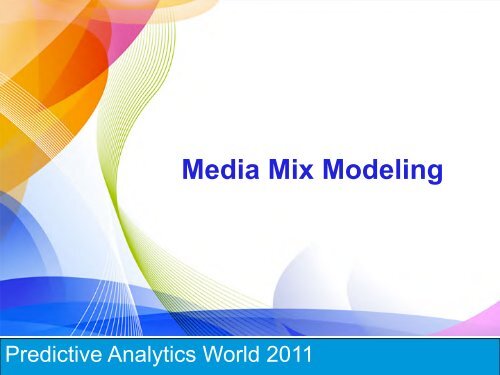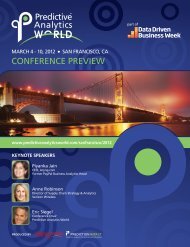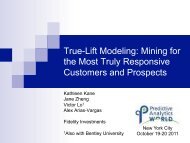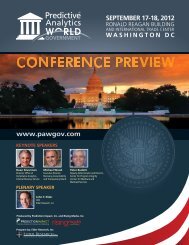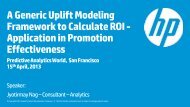analytics2011 - Predictive Analytics World
analytics2011 - Predictive Analytics World
analytics2011 - Predictive Analytics World
You also want an ePaper? Increase the reach of your titles
YUMPU automatically turns print PDFs into web optimized ePapers that Google loves.
Media Mix Modeling<br />
<strong>Predictive</strong> <strong>Analytics</strong> <strong>World</strong> 2011<br />
Copyright © 2011, SAS Institute Inc. All rights reserved.<br />
#<strong>analytics2011</strong>
Media Mix Modeling<br />
Objectives<br />
Demonstrate some of the commonly used techniques and methodologies used to<br />
estimate the impacts of media spend.<br />
Illustrate some of the most frequently encountered problems.<br />
Reference some of the newer Econometric techniques incorporated into SAS/ETS<br />
and Base Stat.<br />
Caveats<br />
It is not possible to provide an extensive catalog in the time provided.<br />
There are far more techniques and challenges than those listed here.<br />
<strong>Predictive</strong> <strong>Analytics</strong> <strong>World</strong> 2011<br />
Copyright © 2011, SAS Institute Inc. All rights reserved.<br />
#<strong>analytics2011</strong>
A Number Of Data Concerns Exist<br />
Simulated Media Spend Data<br />
$3,500,000<br />
$3,000,000<br />
$2,500,000<br />
$2,000,000<br />
$1,500,000<br />
$1,000,000<br />
$500,000<br />
$0<br />
1 3 5 7 9 111315171921232527293133353739414345474951 1 3 5 7 9 111315171921232527293133353739414345474951<br />
Year 1 2<br />
Television_Spend Radio_Spend Newspaper_Spend Direct_Mail_Spend Digital_Spend<br />
<strong>Predictive</strong> <strong>Analytics</strong> <strong>World</strong> 2011<br />
Copyright © 2011, SAS Institute Inc. All rights reserved.<br />
#<strong>analytics2011</strong>
Data Concerns<br />
Stationarity<br />
! A simple “working definition” of stationarity is a<br />
process whose mean, variance and autocorrelation<br />
structures do not vary over time.<br />
Cointegration<br />
<strong>Predictive</strong> <strong>Analytics</strong> <strong>World</strong> 2011<br />
! If variables in a regression model are not<br />
stationary, standard asymptotic assumptions are not<br />
valid (e.g. t-statistics will not follow a t distribution).<br />
! Generally, regression models with non-stationary<br />
predictors (that are not differenced) yield spurious<br />
(even nonsensical) results.<br />
! If a stationary linear combination of non-stationary<br />
regressors exists, these regressors are said to be<br />
cointegrated.<br />
! “Long run” and “short run” dynamic relationships<br />
exist amongst cointegrated regressors.<br />
! Generally, regression models that properly<br />
account for cointegrated predictors will not yield<br />
spurious results<br />
Copyright © 2011, SAS Institute Inc. All rights reserved.<br />
#<strong>analytics2011</strong>
Data Concerns<br />
Exogeneity<br />
! Currently exogeneity is defined in terms of weak,<br />
strong and super exogeneity.<br />
! A regressor is said to be weakly exogenous if<br />
inference on the regression parameter estimates<br />
conditional upon the regressor involves no loss of<br />
information. If weak exogeneity does not hold the<br />
model's dynamic parameter estimates are<br />
inefficient.<br />
! A regressor is said to be super exogenous if it is<br />
weakly exogenous and the regression parameter<br />
estimates do not change when changes in the<br />
regressor's distribution occur.<br />
! A regressor is said to be strongly exogenous if it is<br />
weakly exogenous and the regressor is not<br />
preceded by an endogenous variable (in the model<br />
formulation).<br />
<strong>Predictive</strong> <strong>Analytics</strong> <strong>World</strong> 2011<br />
Copyright © 2011, SAS Institute Inc. All rights reserved.<br />
#<strong>analytics2011</strong>
Data Concerns<br />
GARCH<br />
Multicollinearity<br />
! GARCH – Generalized Autoregressive<br />
Conditional Heteroscedasticity.<br />
! The variance of the current error term (or<br />
innovation) is a function of the size of the previous<br />
period's error term (or innovation).<br />
! Primarily used in variance modeling and may not<br />
necessarily improve forecasts.<br />
! Largely a question of degree or severity.<br />
! If severe multicollinearity exist, the variance<br />
estimates are inflated and the following may be<br />
observed: imprecise (or implausible) and unstable<br />
parameter estimates, a very high r-squared with<br />
statistically insignificant predictors, incorrect<br />
coefficient signs.<br />
<strong>Predictive</strong> <strong>Analytics</strong> <strong>World</strong> 2011<br />
Copyright © 2011, SAS Institute Inc. All rights reserved.<br />
#<strong>analytics2011</strong>
Data Concerns<br />
Autocorrelation<br />
! When model residuals are correlated, parameter<br />
estimates are inefficient, t-statistics and r-squared<br />
values are upwardly biased.<br />
! Autocorrelation can be positive or negative.<br />
! First order autocorrelation is the most common<br />
variant.<br />
! Common causes for autocorrelation include<br />
observations being present in multiple time periods<br />
and omitted variables.<br />
<strong>Predictive</strong> <strong>Analytics</strong> <strong>World</strong> 2011<br />
Copyright © 2011, SAS Institute Inc. All rights reserved.<br />
#<strong>analytics2011</strong>
Multicollinearity<br />
<strong>Predictive</strong> <strong>Analytics</strong> <strong>World</strong> 2011<br />
Copyright © 2011, SAS Institute Inc. All rights reserved.<br />
#<strong>analytics2011</strong>
Multicollinearity<br />
proc reg data=mme.simulated_base;<br />
Title1 'Main and Interaction Effects -- Multicollinearity Demonstration';<br />
where year = 1;<br />
model Log_Sales = Holiday Log_DM Log_TV Log_Radio Log_Paper Log_Digital<br />
LogTVPaper LogTVDigital LogTVHoldy LogRadioHoldy/vif;<br />
output out=p1 p=py r=residual;<br />
run;<br />
quit;<br />
Year 1 sales are regressed against Direct Mail, Television, Radio<br />
Newspaper and Digital Spend levels.<br />
A log-log functional form was assumed to enable easy elasticity<br />
estimates.<br />
<strong>Predictive</strong> <strong>Analytics</strong> <strong>World</strong> 2011<br />
Copyright © 2011, SAS Institute Inc. All rights reserved.<br />
#<strong>analytics2011</strong>
Multicollinearity<br />
Parameter Estimates<br />
Variable DF<br />
Parameter<br />
Es timate<br />
Standard<br />
Error t Value Pr > |t|<br />
Variance<br />
Inflation<br />
Intercept 1 -1.33934 163.23107 -0.01 0.9935 0<br />
holiday 1 3.61428 10.18642 0.35 0.7245 81880<br />
Log_DM 1 0.00484 0.00279 1.73 0.0904 1.45394<br />
Log_TV 1 1.11802 11.78288 0.09 0.9249 51846<br />
Log_Radio 1 0.20417 0.14413 1.42 0.1642 13.56417<br />
Log_Paper 1 -1.48058 13.72226 -0.11 0.9146 68041<br />
Log_Digital 1 2.73806 5.83569 0.47 0.6414 22776<br />
LogTVPaper 1 0.09406 0.9969 0.09 0.9253 253746<br />
LogTVDigital 1 -0.21443 0.43017 -0.5 0.6208 55934<br />
LogTVHoldy 1 -0.53949 0.6456 -0.84 0.4082 65908<br />
LogRadioHoldy 1 0.36448 0.38295 0.95 0.3468 19923<br />
Even though none of the regressors are statistically significant at the<br />
5% confidence level, the Adjusted R-square is .8453.<br />
Only Direct Mail had a variance inflation value less than 10.<br />
Many of the coefficient signs are reversed.<br />
<strong>Predictive</strong> <strong>Analytics</strong> <strong>World</strong> 2011<br />
Copyright © 2011, SAS Institute Inc. All rights reserved.<br />
#<strong>analytics2011</strong>
Multicollinearity<br />
Ridge Regression Code.<br />
proc reg data=mme.simulated_base outvif<br />
outest=b ridge=0 to 0.40 by 0.02;<br />
Title1 'Main and Interaction Effects -- Multicollinearity Demonstration';<br />
Title2 'Ridge Regression';<br />
where year = 1;<br />
model Log_Sales = Holiday Log_DM Log_TV Log_Radio Log_Paper Log_Digital LogTVPaper LogTVDigital<br />
LogTVHoldy LogRadioHoldy/vif noprint;<br />
plot /ridgeplot;<br />
output out=p1 p=py r=residual;<br />
run;<br />
quit;<br />
proc print data=b;run;<br />
<strong>Predictive</strong> <strong>Analytics</strong> <strong>World</strong> 2011<br />
Copyright © 2011, SAS Institute Inc. All rights reserved.<br />
#<strong>analytics2011</strong>
Multicollinearity<br />
Ridge Plots<br />
<strong>Predictive</strong> <strong>Analytics</strong> <strong>World</strong> 2011<br />
Copyright © 2011, SAS Institute Inc. All rights reserved.<br />
#<strong>analytics2011</strong>
Multicollinearity<br />
Regression Plots<br />
<strong>Predictive</strong> <strong>Analytics</strong> <strong>World</strong> 2011<br />
Copyright © 2011, SAS Institute Inc. All rights reserved.<br />
#<strong>analytics2011</strong>
Multicollinearity<br />
Ridge Regression Code Continued.<br />
proc score data=mme.simulated_base score=b(where=(_RIDGE_=0.04)) out=p2<br />
type=RIDGE;<br />
var Holiday Log_DM Log_TV Log_Radio Log_Paper Log_Digital LogTVPaper LogTVDigital LogTVHoldy<br />
LogRadioHoldy;<br />
run;<br />
proc print data=p1;run;<br />
proc print data=p2;run;<br />
A variable selection mechanism is missing.<br />
Each regressor is included (“considered statistically significant”).<br />
<strong>Predictive</strong> <strong>Analytics</strong> <strong>World</strong> 2011<br />
Copyright © 2011, SAS Institute Inc. All rights reserved.<br />
#<strong>analytics2011</strong>
Multicollinearity<br />
GLM Select (Lasso).<br />
proc glmselect data=mme.simulated_base plots=all;<br />
Title1 'Main and Interaction Effects -- Multicollinearity Demonstration';<br />
Title2 'GLM Select -- Lasso';<br />
where year = 1;<br />
model Log_Sales = Holiday Log_DM Log_TV Log_Radio Log_Paper Log_Digital<br />
LogTVPaper LogTVDigital LogTVHoldy LogRadioHoldy<br />
/details=all stats=all<br />
selection=lasso;<br />
*modelAverage nsamples=1000 subset(best=1);<br />
run;<br />
<strong>Predictive</strong> <strong>Analytics</strong> <strong>World</strong> 2011<br />
Copyright © 2011, SAS Institute Inc. All rights reserved.<br />
#<strong>analytics2011</strong>
Multicollinearity<br />
Lasso Variable Selection Summary<br />
Step<br />
Effect<br />
Entered<br />
Effect<br />
Removed<br />
Number<br />
Effects In<br />
Model<br />
R-Square<br />
Adjusted<br />
R-Square SBC ASE F Value Pr > F<br />
0 Intercept 1 0 0 -144.3294 0.0578 0 1<br />
1 LogRadioHoldy 2 0.5747 0.5662 -184.8367 0.0246 67.57
Multicollinearity<br />
Lasso Variable Selection Summary<br />
<strong>Predictive</strong> <strong>Analytics</strong> <strong>World</strong> 2011<br />
Copyright © 2011, SAS Institute Inc. All rights reserved.<br />
#<strong>analytics2011</strong>
Multicollinearity<br />
Lasso Variable Selection Summary<br />
<strong>Predictive</strong> <strong>Analytics</strong> <strong>World</strong> 2011<br />
Copyright © 2011, SAS Institute Inc. All rights reserved.<br />
#<strong>analytics2011</strong>
Multicollinearity<br />
Lasso Variable Selection Summary<br />
<strong>Predictive</strong> <strong>Analytics</strong> <strong>World</strong> 2011<br />
Copyright © 2011, SAS Institute Inc. All rights reserved.<br />
#<strong>analytics2011</strong>
Stationarity<br />
<strong>Predictive</strong> <strong>Analytics</strong> <strong>World</strong> 2011<br />
Copyright © 2011, SAS Institute Inc. All rights reserved.<br />
#<strong>analytics2011</strong>
Stationarity<br />
Vector Autoregression Code (model assumed to be ARMAX(1,1,0))<br />
proc varmax data=mme.simulated_base plots=(impulse) outest=est outstat=stat;<br />
where year = 1;<br />
nloptions tech=newrap maxiter=5000000000 maxfunc=5000000000;<br />
model Log_Sales = Log_TV Log_Digital Log_DM L1_Radio L3_Paper<br />
/print=(all) lagmax = 10 cointtest=(sw) /*dify=(1) difx=(1)*/ p=1 q=1;<br />
output out=out lead=5;<br />
causal group1=(Log_Sales) group2=(Log_TV L1_Radio L3_Paper Log_Digital Log_DM);<br />
causal group1=(Log_TV L1_Radio L3_Paper Log_Digital Log_DM) group2=(Log_Sales);<br />
run;<br />
This model is testing for the need to difference the data.<br />
<strong>Predictive</strong> <strong>Analytics</strong> <strong>World</strong> 2011<br />
Copyright © 2011, SAS Institute Inc. All rights reserved.<br />
#<strong>analytics2011</strong>
Stationarity<br />
Vector Autoregression Code (model assumed to be ARMAX(1,1,0))<br />
Dickey-Fuller Unit Root Tests<br />
Variable Type Rho Pr < Rho Tau Pr < Tau<br />
Log_Sales Zero Mean 0.04 0.6873 0.76 0.8742<br />
Single Mean -2.55 0.7028 -0.88 0.7866<br />
Trend -6.49 0.6818 -1.74 0.7176<br />
Dickey-Fuller Tests indicated model should be differenced<br />
Model Parameter Estimates<br />
Standard<br />
Equation Parameter Es timate Error t Value Pr > |t| Variable<br />
Log_Sales CONST1 -0.93697 0.90437 -1.04 0.3054 1<br />
XL0_1_1 0.40894 0.08564 4.78 0.0001 Log_TV(t)<br />
XL0_1_2 0.0546 0.05846 0.93 0.355 Log_Digital(t)<br />
XL0_1_3 0.00444 0.00217 2.05 0.0462 Log_DM(t)<br />
XL0_1_4 0.10212 0.1133 0.9 0.3719 L1_Radio(t)<br />
XL0_1_5 0.35952 0.14147 2.54 0.0143 L3_Paper(t)<br />
AR1_1_1 0.06687 0.24856 0.27 0.7891 Log_Sales(t-1)<br />
MA1_1_1 0.14939 0.33238 0.45 0.6551 e1(t-1)<br />
The model has an R-square value of .9027<br />
<strong>Predictive</strong> <strong>Analytics</strong> <strong>World</strong> 2011<br />
Copyright © 2011, SAS Institute Inc. All rights reserved.<br />
#<strong>analytics2011</strong>
Stationarity<br />
Vector Autoregression Code (model assumed to be ARMAX(1,1,0))<br />
proc varmax data=mme.simulated_base plots=(impulse) outest=est outstat=stat;<br />
where year = 1;<br />
nloptions tech=newrap maxiter=5000000000 maxfunc=5000000000;<br />
model Log_Sales = Log_TV Log_Digital Log_DM L1_Radio L3_Paper<br />
/print=(all) lagmax = 10 cointtest=(sw) dify=(1) difx=(1) p=1 q=1;<br />
output out=out lead=5;<br />
causal group1=(Log_Sales) group2=(Log_TV L1_Radio L3_Paper Log_Digital Log_DM);<br />
causal group1=(Log_TV L1_Radio L3_Paper Log_Digital Log_DM) group2=(Log_Sales);<br />
run;<br />
This model is estimated in first differences<br />
<strong>Predictive</strong> <strong>Analytics</strong> <strong>World</strong> 2011<br />
Copyright © 2011, SAS Institute Inc. All rights reserved.<br />
#<strong>analytics2011</strong>
Stationarity<br />
Vector Autoregression Code (model assumed to be ARMAX(1,1,0))<br />
Dickey-Fuller Unit Root Tests<br />
Variable Type Rho Pr < Rho Tau Pr < Tau<br />
Log_Sales Zero Mean -75.28
Model Diagnostics<br />
Durbin Watson does not indicate autocorrelations<br />
ARCH test statistic does not indicate heteroscedasticity<br />
Model residuals appear to be normally distributed<br />
Univariate Model White Noise Diagnostics<br />
Durbin<br />
Normality<br />
ARCH<br />
Variable Watson Chi-Square Pr > ChiSq F Value Pr > F<br />
Log_Sales 2.06684 3.35 0.1872 1.54 0.2212<br />
The model order does not appear to have an autoregressive error<br />
Univariate Model AR Diagnostics<br />
AR1 AR2 AR3 AR4<br />
Variable F Value Pr > F F Value Pr > F F Value Pr > F F Value Pr > F<br />
Log_Sales 0.25 0.6185 0.51 0.6043 0.59 0.6249 1.59 0.1962<br />
<strong>Predictive</strong> <strong>Analytics</strong> <strong>World</strong> 2011<br />
Copyright © 2011, SAS Institute Inc. All rights reserved.<br />
#<strong>analytics2011</strong>
Stationarity<br />
Vector Autoregression Code (model assumed to be MAX(1,0))<br />
Dickey-Fuller Unit Root Tests<br />
Variable Type Rho Pr < Rho Tau Pr < Tau<br />
Log_Sales Zero Mean -75.28
Model Diagnostics<br />
Durbin Watson does not indicate autocorrelations<br />
ARCH test statistic does not indicate heteroscedasticity<br />
Model residuals appear to be normally distributed<br />
Univariate Model White Noise Diagnostics<br />
Durbin<br />
Normality<br />
ARCH<br />
Variable Watson Chi-Square Pr > ChiSq F Value Pr > F<br />
Log_Sales 2.27232 1.6 0.4499 1.03 0.3152<br />
The model order does not appear to have an autoregressive error<br />
Univariate Model AR Diagnostics<br />
AR1 AR2 AR3 AR4<br />
Variable F Value Pr > F F Value Pr > F F Value Pr > F F Value Pr > F<br />
Log_Sales 1.08 0.3035 0.99 0.3784 0.76 0.5207 1.58 0.1983<br />
<strong>Predictive</strong> <strong>Analytics</strong> <strong>World</strong> 2011<br />
Copyright © 2011, SAS Institute Inc. All rights reserved.<br />
#<strong>analytics2011</strong>
Forecasts<br />
<strong>Predictive</strong> <strong>Analytics</strong> <strong>World</strong> 2011<br />
Copyright © 2011, SAS Institute Inc. All rights reserved.<br />
#<strong>analytics2011</strong>
Forecasts<br />
Error=(1-(Forecast/Sales))<br />
<strong>Predictive</strong> <strong>Analytics</strong> <strong>World</strong> 2011<br />
Copyright © 2011, SAS Institute Inc. All rights reserved.<br />
#<strong>analytics2011</strong>
Cointegration<br />
<strong>Predictive</strong> <strong>Analytics</strong> <strong>World</strong> 2011<br />
Copyright © 2011, SAS Institute Inc. All rights reserved.<br />
#<strong>analytics2011</strong>
Cointegration<br />
Vector Error Correction Model (VECM) Code<br />
proc varmax data=mme.simulated_base plots=(impulse) outest=est outstat=stat;<br />
nloptions tech=newrap maxiter=5000000000 maxfunc=5000000000;<br />
model Log_Sales Log_TV Log_Digital Log_DM L1_Radio L3_Paper<br />
/print=(all) lagmax = 10 p=4 cointtest=(johansen=(normalize=Log_Sales));<br />
cointeg rank=4 normalize=Log_TV exogeneity;<br />
output out=out lead=5;<br />
causal group1=(Log_Sales) group2=(Log_TV L1_Radio L3_Paper Log_Digital Log_DM);<br />
causal group1=(Log_TV L1_Radio L3_Paper Log_Digital Log_DM) group2=(Log_Sales);<br />
run;<br />
This model is estimated in levels.<br />
Estimating a VECM with differenced data results in a lost of<br />
information.<br />
<strong>Predictive</strong> <strong>Analytics</strong> <strong>World</strong> 2011<br />
Copyright © 2011, SAS Institute Inc. All rights reserved.<br />
#<strong>analytics2011</strong>
Cointegration<br />
Granger Causality<br />
Granger-Causality Wald Test<br />
Test DF<br />
Chi-<br />
Square<br />
Pr ><br />
ChiSq<br />
1 20 54.61
Cointegration<br />
Johansen Rank Test<br />
Cointegration Rank Test Using Trace<br />
5%<br />
H0:<br />
Rank=r<br />
H1:<br />
Rank>r<br />
Eigenvalu<br />
e Trace<br />
Critical<br />
Value<br />
Drift in<br />
ECM<br />
Drift in<br />
Process<br />
0 0 0.4891 188.8512 93.92 Constant Linear<br />
1 1 0.3978 123.7144 68.68<br />
2 2 0.271 74.5222 47.21<br />
3 3 0.2289 43.8567 29.38<br />
4 4 0.113 18.6465 15.34<br />
5 5 0.0697 7.012 3.84<br />
Cointegration Rank Test Using Trace Under Restriction<br />
5%<br />
H0:<br />
Rank=r<br />
H1:<br />
Rank>r<br />
Eigenvalu<br />
e Trace<br />
Critical<br />
Value<br />
Drift in<br />
ECM<br />
Drift in<br />
Process<br />
0 0 0.4892 189.2263 101.84 Constant Constant<br />
1 1 0.3984 124.0615 75.74<br />
2 2 0.2712 74.7639 53.42<br />
3 3 0.2293 44.0806 34.8<br />
4 4 0.1138 18.8118 19.99<br />
5 5 0.0705 7.0963 9.13<br />
<strong>Predictive</strong> <strong>Analytics</strong> <strong>World</strong> 2011<br />
Copyright © 2011, SAS Institute Inc. All rights reserved.<br />
#<strong>analytics2011</strong>
Cointegration<br />
Johansen Rank Test<br />
Hypothesis of the Restriction<br />
Hypothesis<br />
Drift in<br />
ECM<br />
Drift in<br />
Process<br />
H0(Case 2) Constant Constant<br />
H1(Case 3) Constant Linear<br />
Hypothesis Test of the Restriction<br />
Rank Eigenvalue<br />
Restricted<br />
Eigenvalue DF<br />
Chi-<br />
Square<br />
Pr ><br />
ChiSq<br />
0 0.4891 0.4892 6 0.38 0.999<br />
1 0.3978 0.3984 5 0.35 0.9967<br />
2 0.271 0.2712 4 0.24 0.9933<br />
3 0.2289 0.2293 3 0.22 0.9736<br />
4 0.113 0.1138 2 0.17 0.9206<br />
5 0.0697 0.0705 1 0.08 0.7715<br />
<strong>Predictive</strong> <strong>Analytics</strong> <strong>World</strong> 2011<br />
Copyright © 2011, SAS Institute Inc. All rights reserved.<br />
#<strong>analytics2011</strong>
Cointegration<br />
Model Diagnostics<br />
Univariate Model White Noise Diagnostics<br />
Normality<br />
ARCH<br />
Variable<br />
Durbin<br />
Watson Chi-Square<br />
Pr ><br />
ChiSq F Value Pr > F<br />
Log_Sales 2.02311 3.86 0.145 0.04 0.8432<br />
Log_TV 2.027 76.5
Cointegration<br />
Model Diagnostics<br />
Univariate Model ANOVA Diagnostics<br />
Standard<br />
Variable R-Square Deviation F Value Pr > F<br />
Log_Sales 0.3979 0.11948 1.98 0.0139<br />
Log_TV 0.2892 0.16767 1.22 0.2547<br />
Log_Digital 0.499 0.1971 2.99 0.0002<br />
Log_DM 0.4996 3.33832 3 0.0002<br />
L1_Radio 0.6721 0.10855 6.15
Cointegration<br />
Weak Exogeneity<br />
Testing Weak Exogeneity of Each Variables<br />
Variable DF Chi-Square<br />
Pr ><br />
ChiSq<br />
Log_Sales 4 11.01 0.0265<br />
Log_TV 4 5.72 0.2212<br />
Log_Digital 4 23.18 0.0001<br />
Log_DM 4 44.98
VECM Forecasts<br />
<strong>Predictive</strong> <strong>Analytics</strong> <strong>World</strong> 2011<br />
Copyright © 2011, SAS Institute Inc. All rights reserved.<br />
#<strong>analytics2011</strong>
VECM Forecasts<br />
Error=(1-(Forecast/Sales))<br />
<strong>Predictive</strong> <strong>Analytics</strong> <strong>World</strong> 2011<br />
Copyright © 2011, SAS Institute Inc. All rights reserved.<br />
#<strong>analytics2011</strong>
Impulse Response Functions<br />
<strong>Predictive</strong> <strong>Analytics</strong> <strong>World</strong> 2011<br />
Copyright © 2011, SAS Institute Inc. All rights reserved.<br />
#<strong>analytics2011</strong>
Impulse Response Functions<br />
<strong>Predictive</strong> <strong>Analytics</strong> <strong>World</strong> 2011<br />
Copyright © 2011, SAS Institute Inc. All rights reserved.<br />
#<strong>analytics2011</strong>
Impulse Response Functions<br />
<strong>Predictive</strong> <strong>Analytics</strong> <strong>World</strong> 2011<br />
Copyright © 2011, SAS Institute Inc. All rights reserved.<br />
#<strong>analytics2011</strong>
Impulse Response Functions<br />
<strong>Predictive</strong> <strong>Analytics</strong> <strong>World</strong> 2011<br />
Copyright © 2011, SAS Institute Inc. All rights reserved.<br />
#<strong>analytics2011</strong>
Impulse Response Functions<br />
<strong>Predictive</strong> <strong>Analytics</strong> <strong>World</strong> 2011<br />
Copyright © 2011, SAS Institute Inc. All rights reserved.<br />
#<strong>analytics2011</strong>
Impulse Response Functions<br />
<strong>Predictive</strong> <strong>Analytics</strong> <strong>World</strong> 2011<br />
Copyright © 2011, SAS Institute Inc. All rights reserved.<br />
#<strong>analytics2011</strong>
Impulse Response Functions<br />
<strong>Predictive</strong> <strong>Analytics</strong> <strong>World</strong> 2011<br />
Copyright © 2011, SAS Institute Inc. All rights reserved.<br />
#<strong>analytics2011</strong>
Impulse Response Functions<br />
<strong>Predictive</strong> <strong>Analytics</strong> <strong>World</strong> 2011<br />
Copyright © 2011, SAS Institute Inc. All rights reserved.<br />
#<strong>analytics2011</strong>
Impulse Response Functions<br />
<strong>Predictive</strong> <strong>Analytics</strong> <strong>World</strong> 2011<br />
Copyright © 2011, SAS Institute Inc. All rights reserved.<br />
#<strong>analytics2011</strong>
Impulse Response Functions<br />
<strong>Predictive</strong> <strong>Analytics</strong> <strong>World</strong> 2011<br />
Copyright © 2011, SAS Institute Inc. All rights reserved.<br />
#<strong>analytics2011</strong>
Impulse Response Functions<br />
<strong>Predictive</strong> <strong>Analytics</strong> <strong>World</strong> 2011<br />
Copyright © 2011, SAS Institute Inc. All rights reserved.<br />
#<strong>analytics2011</strong>
Impulse Response Functions<br />
<strong>Predictive</strong> <strong>Analytics</strong> <strong>World</strong> 2011<br />
Copyright © 2011, SAS Institute Inc. All rights reserved.<br />
#<strong>analytics2011</strong>
Thank You<br />
Feel free to contact me at dccozine@gmail.com.<br />
<strong>Predictive</strong> <strong>Analytics</strong> <strong>World</strong> 2011<br />
Copyright © 2011, SAS Institute Inc. All rights reserved.<br />
#<strong>analytics2011</strong>
<strong>Predictive</strong> <strong>Analytics</strong> <strong>World</strong> 2011<br />
Copyright © 2011, SAS Institute Inc. All rights reserved.<br />
#<strong>analytics2011</strong>


